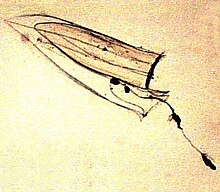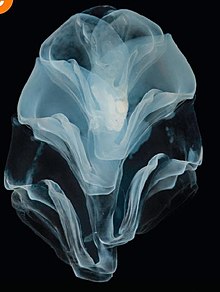| Calycophorae | |
|---|---|

| |
| Morphology of a Calycophorae with aligned nectophores
(Muggiaea atlantica) | |
| Scientific classification | |
| Domain: | Eukaryota |
| Kingdom: | Animalia |
| Phylum: | Cnidaria |
| Class: | Hydrozoa |
| Order: | Siphonophorae |
| Suborder: | Calycophorae Leuckart, 1854 |
| Families | |
| |


Calycophorae is a suborder of Siphonophores alongside two other suborders Physonectae and Cystonectae.[1] This suborder includes the giant siphonophore, (Praya dubia); one of the longest lengthwise extant creatures (40–50m). While the Physonectae have a pneumatophore (a float), nectophore (or nectosome), and a siphosome, Cystonectae lack a nectophore, and Calycophorae lack a pneumatophore.[1] From the bell-shaped nectophores, Physonectae and Calycophorae are called Codonophores or Greek for bell-bearers.[2] The distribution, morphology, and behaviors of Calycophorae species are vast and greatly depend on the species. Calycophoraes typically consist of two nectophores with a siphosome that have many tentacles that grow out of the siphosome.[2] The Calycophoraes move by propelling water out of the nectophore much like how jellyfishes move. The tentacles act as fishing nets where the nematocysts on the tentacles paralyze their prey which are then later fed on. Calycophorae have three life stages, which are the larval development stage, the polygastric stage, and the eudoxid maturation stage.[3] Each Calycophorae colony forms from one fertilized egg.[4]
- ^ a b Dunn, Casey; Rugh, Philip; Haddock, Steven (2005-12-01). "Molecular Phylogenetics of the Siphonophora (Cnidaria), with Implications for the Evolution of Functional Specialization". Systematic Biology. 54 (6): 916–935. doi:10.1080/10635150500354837. PMID 16338764 – via Oxford Academic.
- ^ a b Mapstone GM (2014-02-06). "Global diversity and review of Siphonophorae (Cnidaria: Hydrozoa)". PLOS ONE. 9 (2): e87737. Bibcode:2014PLoSO...987737M. doi:10.1371/journal.pone.0087737. PMC 3916360. PMID 24516560.
- ^ Dunn C (2009). "Siphonophores". Current Biology. 19 (6): R233-4. doi:10.1016/j.cub.2009.02.009. PMID 19321136. S2CID 235312042. Retrieved 2022-04-25.
- ^ "Pelagic Siphonophore". www.aquariumofpacific.org. Retrieved 2022-04-25.